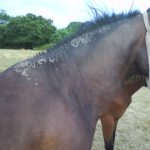Sweet itch (pruritis) is a skin condition that occurs in horses, ponies and other equines. An allergic reaction to bites from Culicoides midges, sweet itch will make the affected animal’s skin inflamed and itchy, and can cause horses to bite, scratch or rub at their skin. Some helpful info….
Some symptoms of sweet itch:
• Skin lesions – especially along the mane, tail and dorsal midline. Lesions near the ears and head are also common
• Hair loss – tail and mane
• Bald patches – the result of permanent hair loss and skin damage
• Broken skin – sore, open skin with occasional bleeding
Prevention of sweet itch is widely regarded as the best strategy for managing the problem.
Prevention techniques include:
• Treating the horse (and/or it’s environment) with insecticides and repellents
• Draining any nearby stagnant water sources where midges breed. Where this is not possible, keep the horse away from these water sources.
• Create barriers – ear-to-tail rugs, fly masks and screens fitted to stable doors and windows can protect your horse from biting insects
• Stable the horse when insect activity is at its highest – usually between 4 pm and 8am
• Fitting ceiling fans in stables can be worth the effort – midges can’t fly against a strong breeze



